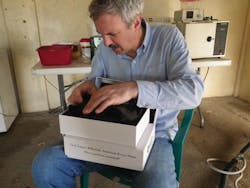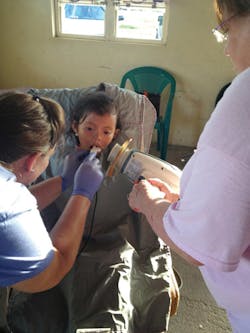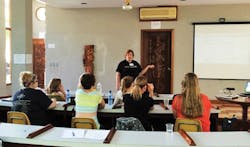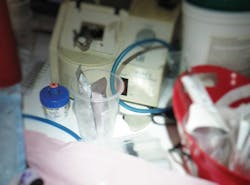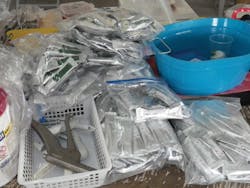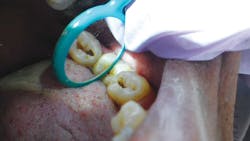Charitable trip to Belize champions minimally invasive dentistry
BY Shirley Gutkowski, RDH, BSDH
Did you ever stop to think about what you could offer on a dental mission trip?
I sure did! I wondered what a hygienist could offer on a trip that had the outcome of a bucket of teeth. I don't perform dental surgery. It's easy to understand that tooth extraction is common in countries where clean water is practically unheard of, and where the nearest dentist is days or weeks away. Dental hygienists also know that if dentists are scarce, a one-time prophy and a once-in-a-lifetime lecture on brushing and flossing aren't going to be very helpful. In the United States, we're telling our patients to brush and floss multiple times a year and they still find it hard to comply. What is a hygienist possibly going to do in a third-world country?
Prevention, that's what!
There's a new kind of dental mission emerging that has a goal of saving as many teeth as possible. It's become entirely possible because of minimally invasive dentistry, and due to the philosophy that saving teeth is possible in third-world conditions. That's how I became involved, as a minimally invasive/minimal intervention dental health-care practitioner.
There are many tools in minimally invasive dentistry that we have here in North America. For a variety of reasons, some dentists hesitate to use them. Dental hygienists can only practice to their overseeing dentist's comfort level.
-----------------------------------------
Other articles by Gutkowski
Think like a pervert: Manage your 'sexy' exposure online
The Autism Experience: Helping practice families deal with autism
-----------------------------------------
These new tools are ozone (gas, oil, water), air abrasion (using aluminum oxide), air polishing (using glycine and bioactive glass called Sylc), and biomimetic materials. Biomimetic or nature-mimicking materials include a variety of products such as glass ionomers (sealants such as GC Fuji Triage), and air slurry polish (sodium bicarbonate, glycine, bioactive glass). The learning curve for practicing this way is a little longer than one might expect. Although there are research papers dating back almost 100 years, some practitioners are a little hesitant to use these products in their practice. This is why International Health Outreach offers continuing education credits for treating the people of Belize with these humane methods.
You can see the full story about how the Belize mission trips fulfilled a dream for Cathy White, a dental hygienist from south Texas, at InternationalHealthOutreach.org. She and her husband love the idea of giving back. Consequently, they started International Health Outreach, an organization that takes health-care providers - mainly dentists and dental hygienists - to Belize to provide citizens with North American-style preventive and minimally invasive dental treatments.
Cathy worked for one of the dentists who forged the way for minimally invasive dentistry. He's a leader in the movement for not only creating minimum preparations in teeth, but for early intervention, which creates the least negative impact on the teeth and patient. Cathy used air polishing, air abrasion, chemical curettage, and most importantly, oxygen therapy (ozone) on her patients for many years.
Early intervention requires a mode of action beyond just fluoride treatment. At Cathy's office, all microlesions were treated with ozone and the office used glass ionomer as a biomimetic treatment for those lesions. Her doctor, Dr. J. Tim Rainey, used glass ionomer for sealants and guaranteed the teeth with the sealants for life. He would replace the sealant for free. If the tooth were to ever develop decay, he would place a complimentary filling.
That's the philosophy to which International Health Outreach also adheres. The citizens of Belize are treated with minimally invasive dentistry that features glass ionomers and ozone gas in the majority of their treatments. The newest evolution is the training that the North American and Central American dentists get at the hands of the North American mentors. They are taught how to use air abrasion, oxygen/ozone therapy, and biomimetic air polishing.
Day one - The volunteers are treated to a welcome reception where everyone can meet one another. This is a laid-back time. The volunteers learn the lay of the land and become acquainted with their accommodations. IHO makes sure the volunteers are supported in the best possible environment. The November 2014 trip was hosted at a resort with ample running water, flush toilets, private showers, and semiprivate bungalows. The group ate all their meals together in the large dining area.
Oral cancer screening lights were unpacked and used.
Day two - Everyone meets for a full day of education and training in the methods of the minimally invasive practice. This is a day of paradigm shifting! Not only are volunteers there to save teeth, they are side-by-side with local dentists. Most trips extract fewer than 10 teeth out of 300 to 400 patients seen.
The idea of minimal intervention works perfectly in this setting. Closer to the equator tooth enamel becomes thicker and denser. The decay is different. It can be very aggressive, but usually only on a few teeth. Removing decay early and using a biomimetic glass ionomer such as Triage allows the practitioner to save more teeth. Because IHO works closely with the national health ministry and keeps accurate records, the group can follow the sequelae of the cases and know the results.
Most dentists do not understand glass ionomers. First, they think that the tooth needs to be dry to apply it, particularly in the case of Triage, which is marketed as a sealant. The opposite is true - glass ionomers need moisture to fuse to the tooth. That's what makes it a great material in these situations. Belize has a very humid climate, and keeping teeth dry with mobile equipment is difficult too. The heat and humidity means certain modifications in preparing the material need to be undertaken.. Readying the material needs modification, and shorter mixing times and cooling the capsules works. This gives the practitioner ample time to place the material as a sealant or filling. The material sticks to the tooth much better. The idea of ART (atraumatic restorative treatment) has its roots in glass ionomers. Success of teeth repaired with glass ionomer in conditions where there is no electricity for drills has been proven in many studies. A few studies even looked at the filled teeth up to six years after treatment and found the teeth were still stable.
Studies of the material show that it mechanically fuses to the tooth so completely that even if it's not visible to the naked eye, it's still present acting as a fluoride battery, recharging with toothpaste and releasing fluoride into the microenvironment around it. Using glass ionomers on the proximal surface of a tooth can protect the tooth it's placed on as well as the tooth adjacent to it.
Glass ionomers have been around for a long time. They lost favor as a restorative material because they're "soft." They don't last long in traditional preps, but they're the perfect material for sealants, cervical decay, and one- or two-surface fillings in primary teeth. They're also useful for people who cannot care for themselves. Combine them with air abrasion and ozone gas, and you have the perfect trio for missionaries intent on saving teeth.
The reason so many teeth are lost in traditional mission trips is because once a tooth is decayed, there's no other way to stop the infection from spreading. In early studies using ozone gas, root decay was reversed with no other treatment than a 10-second exposure of a low concentration of ozone. Results were apparent two years after the application of the gas with no other treatment. Depending on the case presented, disinfecting the minimal prep using ozone and then applying a biomimetic material gives missionary dentists and dental hygienists an option. On the November 2013 trip, missionaries removed fewer than 100 teeth in over 3,000 teeth treated. On the November 2014 trip, only seven of more than 5,000 treated teeth were removed.
Ozone therapy is a modality that has garnered a lot of interest and has been slowly gaining acceptance in U.S. dental communities. It's been used for over 80 years as a dental adjunct in Canada, Europe, Africa, the Middle East, and Central and South America.
To wrap your thinking around ozone therapy, imagine you could virtually sterilize a fissure before sealing it. Imagine after removing decay and just before hitting the pulp chamber, you sterilized the tooth with ozone gas before then adding a remineralization product that solidified the dentin before placing a biomimetic material. That's what ozone gas does; it kills bugs and stimulates healing. Most people get a little uncomfortable with the use of the term ozone because of the atmospheric ozone alerts and the hole in the ozone layer. On the contrary, medical ozone is safe. Besides its uses in medicine and dentistry, municipalities across the globe have been using it to disinfect their water supplies for over 100 years.
Learning these lessons is one thing, but putting them into practice is another. Using glass ionomers on numerous patients all day for days gives a practitioner a solid experience. We usually see 350 to 400 patients during one mission tip. This goes far beyond a half-day, hands-on lecture here in the U.S., after which the need exists to find paying customers to "practice" on. The missionary dentists and dental hygienists receive a lot of hands-on time, and they are competent users when they get home. This education puts wheels on the minimally invasive, early intervention bus. It helps clinicians get up to speed using advanced materials that they can use in their day-to-day practice.
After the didactic day, a short visit to the site allows everyone to see the clinic setup and anticipate what will unfold the following day.
Days 3 to 6 - We see and treat patients, lots of patients! As with most mission trips, people line up in the morning and wait a good part of the day to be seen by the North American practitioners. We see patients with all levels of dental knowledge and health, but with only one level of supreme gratefulness.
Ozone gas and ozonated water are used after cleaning out decay with the air abrasion units. This treatment removes all infective agents and assures the decay won't continue after we leave.
The tooth can then be filled with a restorative glass ionomer material or be sealed with Triage. Because we work so closely with the Belize Health Department, we know how our program is received and how long the glass ionomer restorations last. They last a long time.
We also teach students how to use ozone in other ways, such as treating endodontic lesions, gingival abscesses, herpetic lesions/cold sores, and denture fungal sores. Periodontal pockets are treated and filled with ozonated oils. (We thank OzoneOils.com for their donations.) The ozone gas is also used to sterilize some of the instruments and equipment. The ozonated water is used for lavage of patients' mouths, and to disinfect surfaces and clean and sterilize water lines. We use piezo scalers with ozonated water to remove hard deposits. Oral hygiene instructions are provided using toothbrushes donated by Sunstar-Butler. Thank you, Sunstar.
The final day - On the last day, we play. The IHO group plans an outing for everyone to see the beautiful country and experience the history of Central America. Mayan ruins or zip lining never get old, and the bonds between the people who attend are formed for life.
If you're looking for a way to give back, learn about and enjoy a different culture, and learn new dental technologies and techniques that will serve your own patients, sign up for one of the IHO group trips. Belize is in the central time zone and is a short 90-minute flight from Atlanta or Houston. As this mission grows, other health disciplines also contribute. The November 2014 trip included a chiropractor/acupuncturist and a massage therapist who treated the citizens of Belize with their unique skills and talents. It's truly a multinational interdisciplinary group.
Special thanks to Cathy and Tom White, owners of IHO, and ozone mentors Dr. Eric Zaremski, Dr. Richard Ehrlich, and Helga Guba, RDA.
Special thanks to GC America for donating the primary materials used in the mission to help save teeth, to Crosstex for contributions of gauze, saliva ejectors, suction tips, and patient bibs, to Air Techniques for loaning a Nomad X-ray head, to Oral ID for donating oral cancer screening lights, and to all the practitioners who donated goods from their own reserves. RDH
Shirley Gutkowski, RDH, BSDH, is the author and publisher of The Purple Guide series of books for dental hygienists. She is also the host of the popular daily radio podcast on Blog Talk Radio and Stitcher: Cross Link Radio. Gutkowski is a faculty coach at CAREERfusion. She can be reached for speaking or consulting at [email protected].

